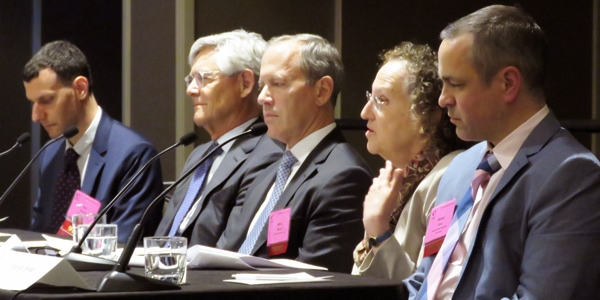By Rich Heidorn Jr.
WASHINGTON — Should FERC should begin requiring supply curve analyses in its merger reviews? It’s a no-brainer to Cynthia Bogorad, who has attempted to submit them as an intervenor challenging acquisitions.
“I’ve got black and blue marks to show that that … has not been a very successful strategy, because you don’t have the data or the time to get the data in [the] 60 days” allowed for filing a protest, Bogorad, a partner at Spiegel & McDiarmid, said during a panel discussion at last week’s Energy Bar Association annual meeting.
“And the commission has in my experience been very reluctant to accept intervenor analysis. We’ve presented a strategic bidding analysis in a case that the commission just said, ‘No, don’t do that.’ So, I think …. the commission [requiring merging companies to provide the analyses] would be very important because it’s hard to get them in [evidence] otherwise.”
The commission said it was considering changes in its merger policy in a September 2016 Notice of Inquiry (RM16-21). It noted that its market power evaluation for mergers, which are regulated under Section 203 of the Federal Power Act, differs from that used in market-based rate applications under Section 205. The commission asked for input on several issues, including whether it should add supply curve and market share analyses to its reviews, and whether it should require applicants to submit consultant reports and other internal reports that assess the competitive effects of the merger, as the Justice Department does. (See FERC Considers Changes to Market Power Analyses.)
FERC currently requires merger applicants to perform a competitive analysis screen unless they can show that the acquisition does not increase their generation capacity in the relevant geographic markets or that the increase is de minimis. The screen includes a delivered price test (DPT), which has been essentially unchanged since its introduction in 1996 and generally focuses on the short-term energy market “with far less detail and attention given to the other relevant products,” FERC said.
False Positives?

Mike Naeve, a partner with Skadden, Arps, Slate, Meagher & Flom, said FERC’s screening already prevents acquisitions that have no competitive harm.
“If we decide on top of that we’re going to add three or four other screens … I think there would be a lot more false positives,” Naeve said. “And I also think the amount of time and money and effort to prepare and advise clients for these filings [will] go up astronomically. So, the question is: Is the current process so flawed that it needs to be fixed?”
Naeve also was not convinced that FERC needs to adopt DOJ’s tools.
“As long as I’ve been doing this, I don’t know [of] a transaction where the commission said this transaction looks fine with us … and the DOJ, using these other methodologies and tools … says, ‘Oh, there’s a problem there FERC that you missed because your methodology is too simple.’ I don’t think that’s ever happened.”
Amery Pore, an economist in FERC’s Office of Energy Market Regulation, disagreed with Naeve’s characterization of the potential changes, which the commission is still reviewing. The comment period in the NOI expired in December 2016.
Flexibility?
“I guess one way to read the NOI would be to see these additional tests as extra hurdles to jump through,” Pore said. “But alternatively, you could think of them as employing the flexibility that was actually considered back in 1996 when the DPT wasn’t intended, when it was implemented, to be the screen to use.”
“If these were alternative tools to show it really is a false positive and there aren’t competitive problems, then I think we would all say that’s worth doing,” Naeve agreed. “But I would also say you [should not] need to do it in your application unless you have a screen failure.”
Naeve said he’s seen intervenors opposing mergers submit “very simplistic” supply curve analyses.
“To do it right you have to take into consideration a lot of factors … like the [generators’] ramp rates [and] minimum run times and minimum down times; the fact that sometimes in an RTO-type market … a transmission constraint that raises prices on this side of the constraint actually lowers prices on the [other] side of the constraint, so if you have generation there you’re actually losing money. … There’s just a lot of factors [that affect] the profitability of withholding.”
“That’s why it’s hard for intervenors to do it in the 60 days they have to protest,” Bogorad replied.
Mark Niefer, deputy chief legal advisor in the Justice Department’s Antitrust Division, said it’s important to avoid inconsistencies between DOJ and FERC reviews because the potential harm to consumers is so high.
“You’re talking about markets that are tens of billions of dollars in size, such that a very, very small exercise of market power over a very short period of time can impose harm on consumers … that are in the tens of millions of dollars,” he said. “So, my own personal preference when conducting a merger analysis [is] to tend to try to avoid false negatives rather than false positives. I just think the stakes are too high. And I think history bears that out. If you look back at California — the exercise of market power [during the 2000-2001 Western Energy Crisis] pretty much put a damper on restructuring in the United States. … And I think that damper still is in place.”
The panel was moderated by Eric Korman, vice president of Analysis Group.





